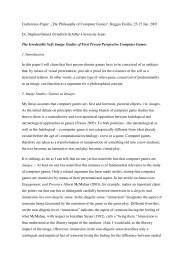Playing Dress-Up: Costumes, roleplay and imagination
Playing Dress-Up: Costumes, roleplay and imagination
Playing Dress-Up: Costumes, roleplay and imagination
Create successful ePaper yourself
Turn your PDF publications into a flip-book with our unique Google optimized e-Paper software.
<strong>Playing</strong> <strong>Dress</strong>-<strong>Up</strong> Ludica<br />
• Doll-Play: In this mechanic, the player is dressing up a character that is distinctly not herself, but<br />
over which she has (often god-like) agency. In analog form, this manifests in the form of physical<br />
dolls <strong>and</strong> paper dolls, or the boy-variant “action figures.” Digital variations of this mechanic include<br />
Barbie Fashion Designer, mentioned earlier, a hybrid form which broke new ground by allowing<br />
girls to design fashions, then print out the results on special printable fabric to outfit their actual<br />
Barbie dolls. (Figure 1) The Sims series can also be seen as a variation of the doll-play mode. (Figure<br />
2) One of the authors of this paper has created an analog game entitled Fashionistas that translates<br />
this into a board game mechanic in which players have to find lost wardrobe items for members of a<br />
glamorous girl-b<strong>and</strong>. (Fron 2004) In each of these contexts, the player does not inhabit the character,<br />
but merely exercises agency upon it.<br />
Figure 1: Barbie Fashion Designer allowed girls<br />
to make real clothing for their Barbie dolls.<br />
Figure 2: Fashion <strong>and</strong> furnishings extension pack for<br />
The Sims 2.<br />
• Identity/Avatar/Costume: This is the mechanic in which the player is appearing as the character. In<br />
the real world, this manifests as a costume, <strong>and</strong> can take a variety of forms. In open-ended<br />
metaverses, the identity is primarily a form of personal expression, but does not have points or<br />
gameplay associated with it per se. On the other h<strong>and</strong>, in most role-playing games, the player must<br />
begin by selecting a race, class <strong>and</strong> gender, as well as a name that serves as her marker of persistent<br />
identity. These are almost always fixed <strong>and</strong> determine the player’s appearance, what he or she can<br />
wear, <strong>and</strong> how the appearance <strong>and</strong> skills of her character can evolve over time. This mechanic is tied<br />
to the Armor/Instrumental costume play mechanic described below.<br />
It should also be noted that these two modes are not always absolute. There are many cases where the<br />
player relationship to the character is ambiguously balanced somewhere between these extremes.<br />
<strong>Dress</strong>-up Mechanics<br />
The following half-dozen sample dress-up mechanics primarily relate to the second mode described<br />
above, that in which the player actually takes the role of the game character:<br />
• Armor/Instrumental: In traditional MMOGs, especially those with medieval fantasy themes,<br />
dress-up is not merely a form of self-expression, but also an instrumental part of gameplay,<br />
deeply tied to your character’s performance. These games attach elaborate “Armor Class” values<br />
to various modular armor elements, each of which is assigned a “slot” that correlates to a body<br />
Philosophy of Computer Games 2007 Page 5






